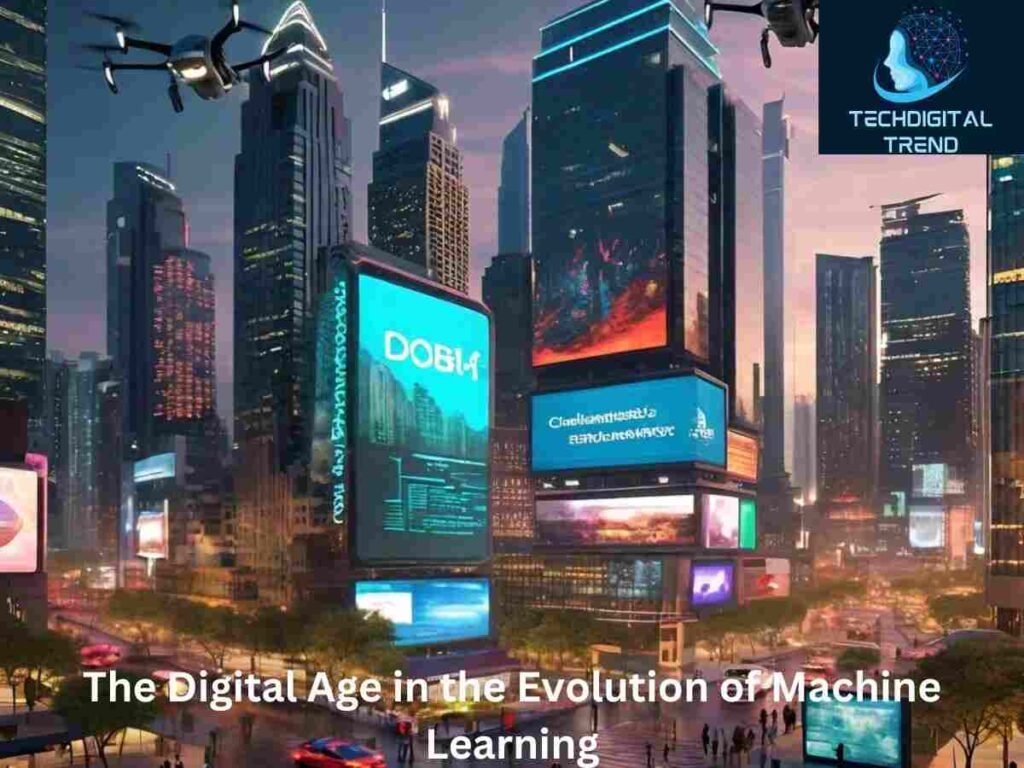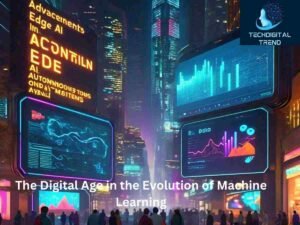Table of Contents
ToggleThe Digital Age
In the current digital era, machine learning is a subset of AI. It focuses on creating algorithms that learn from data. They make predictions or judgments without explicit programming. Machine learning is becoming used due to rapid technological improvements. It is revolutionizing many industries. It is reshaping how we use technology. And, it is influencing the future of work. For example, it powers personalized recommendations on streaming platforms and self-driving cars. This article explores the growth of machine learning. It covers its uses and challenges. It also covers recent progress, future trends, and its impact on society in the Digital Age.
Historical Background
Machine learning’s roots go back to the mid-20th century. Then, researchers began exploring algorithms for enabling computers to learn from data. One of the pioneers in this field was Arthur Samuel, who coined the term “machine learning” in 1959. Samuel developed algorithms for game-playing programs, like checkers. They improved over time through experience. Over the decades, there were big milestones. They include the start of neural networks. Also, the rise of big data and the increase in computational power. These things moved machine learning forward in the Digital Age.
Key Concepts in Machine Learning
Machine learning includes many techniques. These include supervised, unsupervised, and reinforcement learning. In supervised learning, algorithms learn from labeled data. Each example has a label or outcome. The goal is to make predictions or decisions. Common applications of supervised learning include image recognition, speech recognition, and predictive analytics.
In unsupervised learning, algorithms extract patterns from unlabeled data. The input data is not labeled with the correct output. Clustering and dimensionality reduction are common tasks in unsupervised learning. Behavioral psychology inspires reinforcement learning. It involves learning to make decisions through trial and error. This happens by interacting with an environment. The goal is to maximize rewards. This happens in the Digital Age.
Applications of Machine Learning
Machine learning has found uses in many sectors. These include healthcare, finance, marketing, and transportation in the Digital Age. In healthcare, it aids in disease diagnosis. It helps make personalized treatment plans and find new drugs. It also helps analyze medical images. Financial institutions use machine learning. They use it for fraud detection, risk assessment, algorithmic trading, and customer management.
In marketing, machine learning powers recommendation systems. It also powers customer segmentation strategies, sentiment analysis, and targeted advertising. In transportation, it enables autonomous vehicles, route optimization, traffic management, and predictive maintenance.
Challenges in Machine Learning
Despite its potential, machine learning faces several challenges in the Digital Age. Data privacy is a big issue. It involves balancing data use with privacy rights. Biased datasets and algorithms also cause bias and fairness issues. They lead to unfair outcomes. Understanding machine learning models is hard. It’s true, especially in high-stakes applications. In these cases, decisions impact human lives. Additionally, the lack of transparency in complex models hinders trust and accountability.
the Digital Age Recent Advances
Recent years have seen remarkable advances in machine learning. Progress in deep learning drove them. This includes natural language processing (NLP) and computer vision. Deep learning techniques have achieved record performance. They include CNNs and RNNs. They’re used for tasks. Tasks include image and speech recognition, and understanding language. NLP models, like transformers, have changed language understanding and generation. They enable applications such as language translation, sentiment analysis, and text summarization. Computer vision algorithms have reached human-level performance. They can do tasks like object detection, image segmentation, and facial recognition. This success paves the way for use in self-driving cars, healthcare, and surveillance.
Future Trends
Looking ahead, several trends will shape machine learning in the Digital Age. Edge computing processes data closer to its source. It will let IoT devices do real-time inference. It will also reduce latency in important applications. Federated learning trains models on decentralized devices. It preserves data privacy. It holds promise for collaborative learning in distributed environments. Quantum machine learning uses quantum computing’s immense power. It may unlock new frontiers in solving hard problems and simulating quantum systems. XAI techniques will improve how interpretable machine learning models are. Users can observe how decisions are made and identify biases.
Impact on society And the Digital Age
Organizations have adopted machine learning. It has big effects in the Digital Age. It brings chances for innovation, growth, and a better life. But, it also raises concerns about job loss, retraining, and income gaps. Ethics, such as bias and privacy, need care. They need to ensure that machine learning helps all society. This needs transparency and accountability. Policymakers, industry stakeholders, researchers, and advocacy groups must collaborate. This is essential to address these challenges and foster responsible AI.
In conclusion
Machine Learning has revolutionized numerous industries and aspects of our lives, breaking barriers and transforming the way we live and work. From its early days to the current advancements in Deep Learning, Machine Learning has come a long way, enabling machines to learn and improve on their own. While challenges like data quality, explainability, and ethics need to be addressed, the future of Machine Learning holds immense promise, with advancements in Edge AI, Explainable AI, and Autonomous Systems. As we continue to push the boundaries of Machine Learning, we’ll see even more innovative applications and breakthroughs that will shape our world.
Final Thoughts
- Machine Learning has transformed industries like Healthcare, Finance, and Marketing.
- Deep Learning has enabled machines to learn and improve on their own.
- Challenges like data quality, explainability, and ethics need to be addressed.
- The future of Machine Learning holds immense promise with advancements in Edge AI, Explainable AI, and Autonomous Systems.
Open this link: Tap to here
















